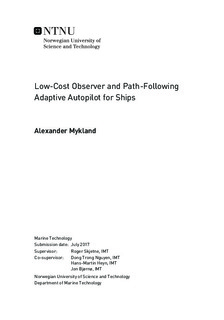| dc.description.abstract | In this thesis a signal-based observer and a path-following autopilot design will be derived and implemented on the model vessel C/S Enterprise I. Using scaling methods the goal is to transfer the controllers into a full scale model of R/V Gunnerus without extensive tuning or redesign. The control system will be designed to fulfill a low-cost concept using a signal-based observer and adaptive controllers. This is done in order to avoid using model parameters, which often require lengthy and expensive sea trials. This may facilitate testing which now to a greater extend can be done using laboratories and models instead of actual full-scale vessels. Finally, a guidance loop will be integrated in the control system which will make both vessels able to follow predetermined paths using the low-cost control system.
By using maneuvering theory the 3 DOF vessel model of C/S Enterprise was reduced into uncoupled models for surge-speed, sway-yaw- and yaw-motion. Using normalization methods, these models were tested with respect to scaling, simplicity and performance. Comparison were done with the full-scale 6 DOF R/V Gunnerus model. This resulted in that the surge-speed- and the 1st order Nomoto- model for heading control were chosen as basis for the controller.
Next, a signal-based (or kinamtic) observer design was derived, implemented and tested with and without noise on the acceleration measurements. It proved that the integrator filters worked as expected and that the errors converged towards zero. For the control design, MRAC was chosen as the preferred control scheme. Two different normalized heading controllers in addition to a normalized surge-speed controller were derived and simulated based on the maneuvering models chosen earlier. Tests, were done with and without robustification for the C/S Enterprise I and with scaling on R/V Gunnerus. The simualtions produced satisfying results showing that the scaled adaptive controllers could easily be transferred to a full-scale vessel.
Finally, guidance was added to the autopilot design. Path generation for both regular- and parameterized paths were generated and path-following as well as path-tracking algortihms. Extensions were also implemented in order to cope with current effects. Simulations for both C/S Enterprise I and R/V Gunnerus proved that the vessels were able to follow these paths even when current forces acting were on the vessels. These simulations tested the whole control system developed throughout the thesis and the overall results were satisfying. As a conclusion, the scalable low-cost autopilot design and signal-based observer were succesfully implemented and simulated for both vessels, yielding good results. | |

